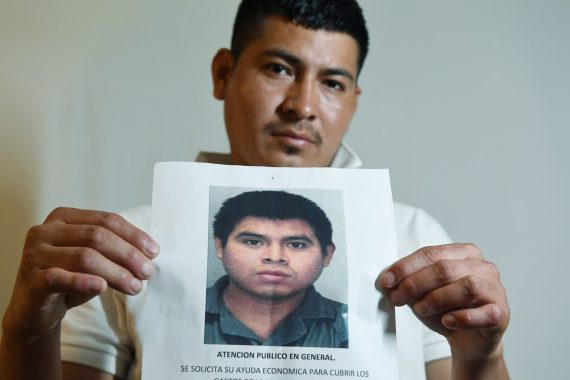
Noe Sanchez Amaya, 27, an uncle of Giovanny Martinez, holds a flier Fairfax County police circulated as they tried to identify Martinez after he was fatally shot. (Matt McClain/The Washington Post)
(12-19-16) Shortly after 2 p.m. on a hot August day earlier this year, a 29 year-old Hispanic man approached a police officer seeking help. Yovani Amaya Gomez appeared to be in some sort of mental crisis. A little more than eight hours later, Gomez would be fatally shot on the hospital grounds where he had been taken for help.
Details about the shooting were made public Friday (12-16) by Virginia Commonwealth Attorney Raymond F. Morrogh who concluded that Deputy Sheriff P. McPartlin was justified in fatally wounding Gomez.
Unfortunately, the investigative report that Morrogh released lacks critical information about what happened inside the Fairfax Inova Hospital where Gomez was taken before the shooting — information that might have been helpful in preventing future fatal encounters.
The shooting was investigated by detectives from the Criminal Investigation Bureau and Crime Scene Section of the Fairfax County Police Department. According to their findings, Gomez approached Fairfax County Police Officer K. Woodward as he was sitting in his cruiser. Gomez spoke limited English but Officer Woodward heard Gomez utter the word “loco.”
From the detective’s report: “Officer Woodward used his cell phone and an App called “Google Translator” to ask Gomez if he wanted to hurt himself. Gomez seemed to indicate that he did want to hurt himself by answering “Si.”
Paramedics were called to transport Gomez to Fairfax Inova Hospital and during that ride Gomez “pointed to his head and said, ‘Voices.’”
Officer Woodward was so concerned about Gomez’s mental state that he followed the paramedics to the hospital, specifically asked the medical staff to investigate Gomez’s mental state and whether he was a threat to himself or others, and further said that he would remain at the hospital in case Gomez needed to be driven to the Merrifield Crisis Center for a mental examination and possible treatment.
He was told by hospital staff that he could return to his patrol duties because Gomez was not mentally unstable but simply was complaining about a stomach ache.
How did the hospital reach this conclusion? It is after Gomez arrived at the hospital, that the detectives’ report fails to answer a series of key questions. According to the report, “A physician and Spanish speaking nurse examined Mr. Gomez.”
- While everyone else who played a key role in this incident is identified by name, neither the doctor nor the nurse is identified. Why is this important? Because emergency room doctors are not psychiatrists and while hospital emergency room workers often are deluged with patients in the midst of psychiatric problems, some ER doctors have received minimum training in recognizing and diagnosing psychiatric issues. It is difficult to discern from the detectives’ report if they actually spoke to either the doctor or nurse, or instead relied on medical records provided by the hospital. Without the identity of the doctor, it is impossible for the prosecutor or the public to know how qualified the physician was to determine if Gomez had a mental disorder.
- Fairfax Inova Hospital has a psychiatric unit. Gomez was brought to the hospital, in part, because both Officer Woodward and the paramedics believed that he might be having a mental issue. Yet, there is no indication in the detectives’ report that a psychiatrist from the unit was consulted about Gomez or if he ever met one. Had Mr. Gomez been showing signs of a heart attack would the emergency room doctor have consulted a cardiologist?
- The detectives reported that a “Spanish speaking” nurse was asked to communicate with Mr. Gomez but there is no mention of what, if any training, she might have had when speaking to psychiatric patients. Having a mental illness often is shameful in many cultures. How this nurse asked questions to Gomez may have played a critical role in how he answered her/his questions.
- According to the report, “They (doctor and nurse) advised, “Officer Woodward that Mr. Gomez denied any mental-health issues and further said that he did not want not hurt himself.” As anyone with a mentally ill loved one can tell you, oftentimes individuals with mental disorders are convinced they are perfectly fine when asked if they have a mental disorder. Some mental health professionals argue that self-awareness is what is first impeded during a mental break causing a lack of insight. This was certainly the case with my son who was convinced that he was fine and that the rest of us were confused when an emergency room doctor questioned him. The same is true about asking a patient if he/she is intent on harming themselves or others. While it is a key question, it depends on a patient being forthright and insightful. Patients have been known to lie to escape involuntary hospitalization. Again, a psychiatrist should have been conducting an evaluation.
- According to Prosecutor Morrogh, “Doctors ordered numerous laboratory and radio-graphic tests upon Mr. Gomez including blood work and a CT scan. All of these tests were negative including one for blood alcohol content.” The fact that tests were negative should have raised alarm bells about a mental illness, not quieted them. Not everyone who comes into an emergency room complaining of “unspecified pain and nausea” needs to be seen by a psychiatrist. But the circumstances and suspicions that led to Gomez being taken to the hospital would suggest that if standard medical tests showed normal results, the likelihood of his problem being linked to mental illness actually increased. It is important to remember there are no blood tests, scans or other medical tests used in emergency rooms to detect mental illnesses. The diagnosis is chiefly made by a psychiatrist observing and questioning a patient. This is why it is so important for psychiatrists to be involved. If the detectives and Prosecutor Morrogh considered normal test results as proof that Gomez was sound mentally, they are mistaken.
- The report reads: “Physician examination of Mr. Gomez showed his blood pressure, heart rate, gait, coordination, respiration and temperature were all within normal range. He was alert and oriented to person, place and time.” While it is helpful to know that Gomez was oriented to person, place and time, that is not proof that he was mentally okay. Bipolar disorder is a serious mental illness that is a mood disorder, and while a patient can have delusional thoughts, many patients can present themselves well. My son was fully aware of his name, where he was, and was able to explain what the term “crying over spilled milk” meant. Yet, he also was convinced that God had sent him on a secret mission.
- The report notes: “The Emergency room physician assessed his mental condition as follows: “Psychiatric: He has a normal mood and affect. His behavior is normal. Thought content normal.” He was not in distress other than his initial complaint of abdominal pain and nausea. Doctors diagnosed him as suffering from general weakness.” At the risk of being redundant, if mental health issues prompted Gomez being taken to the hospital, then he should have been examined by a psychiatrist, preferably one who spoke Spanish. There is nothing in the report that suggests a psychiatrist interviewed Gomez.
- Convinced that Gomez was simply showing signs of “general weakness,” he was released from the emergency department. But he got the attention of a security guard before leaving the hospital, according to the report. “Old Dominion Security Guard Ezra Carter was on duty…he encountered Mr. Gomez in the lobby as he was leaving the Emergency Room…It appeared to Mr. Carter that Mr. Gomez might need some assistance so he approached Mr. Gomez and with the help of an interpreter, determined that Mr. Gomez wanted to go to a homeless shelter…Mr. Carter then walked Mr. Gomez to the appropriate bus stop.” Clearly Security Guard Carter didn’t speak Spanish. That being the case, what was it about Gomez’s actions that caused the security guard to decide that Gomez “might need some assistance?” Was it as simple as Gomez needing directions? The hospital does have a maze like structure. Or was there something more alarming about Gomez’s behavior? Is it common practice for a security guard to leave his guard station inside the hospital and escort someone to a bus stop? Again, there is no explanation in the detectives’ report or in Prosecutor Morrogh’s remarks.
- The unnamed emergency room doctor determined that Gomez showed “normal mood and affect. His behavior is normal. Thought content normal.” There were additional references in the report about him being calm, cooperative, and non-combative while in the hospital. Yet, shortly after being discharged and escorted to a bus stop, the detectives report that Gomez armed himself with a sign post and began striking people with it. This led to Deputy Sheriff P.McPartlin arriving and shooting Gomez after he rushed at the deputy swinging the post much like a “sword. ” Why did someone who had been calm for hours suddenly become so violent? We don’t know. Was he misdiagnosed? Is it possible that Gomez was having a reaction to medication that he was given in the hospital? Some medications for mental illnesses can result in paranoia, delusions, and mood swings that make individuals aggressive. None of this is addressed in the report.
- At anytime, did the hospital attempt to reach Gomez’s relatives to ask if he had a history of mental illness? Families are not the enemy in these instances.
- The hospital knew that Gomez was homeless because it gave him a list of shelters when it discharged him. While not everyone who is homeless has a mental illness, being homeless sends up a red flag because so many individuals who are homeless are ill.
The Fairfax detectives who investigated this tragedy and Prosecutor Morrogh’s primary interest was determining if Deputy P.McPartlin was justified in shooting Gomez. But as public guardians, the detectives and Prosecutor Morrogh also bear a responsibility to expose weaknesses in our system that may need to be corrected to prevent further loss of life to police officers and citizens.
Fairfax Inova Hospital has refused to make information public, making the tired HIPAA excuse about protecting patient privacy. The detectives investigating the shooting and Prosecutor Morrogh could have obtained answers to all of the questions that I have posed. It is unfortunate that they did not.
Fairfax County’s Board of Supervisors recently voted to hire a Police Auditor to monitor fatal police shootings and create a nine member Citizen Review Panel to hear complaints. This investigation demonstrates why it will be important for someone who has knowledge of mental health and law enforcement practices to be named as the police auditor and for at least one panel member on the CRP to have knowledge of mental health issues when reviewing possible police misconduct. According to the National Alliance on Mental Illness, 40 percent of persons with serious mental illnesses will have an encounter with law enforcement during their lives. When it comes to police shootings, one-fourth or in some communities one third of all fatal police shootings involve someone who has been diagnosed with a mental disorder and persons with mental illnesses are sixteen times more likely to be fatally shot by the police than the general public.
To read the prosecutor’s report click here scan

Signpost that Gomez was using as a weapon when fatally wounded.



